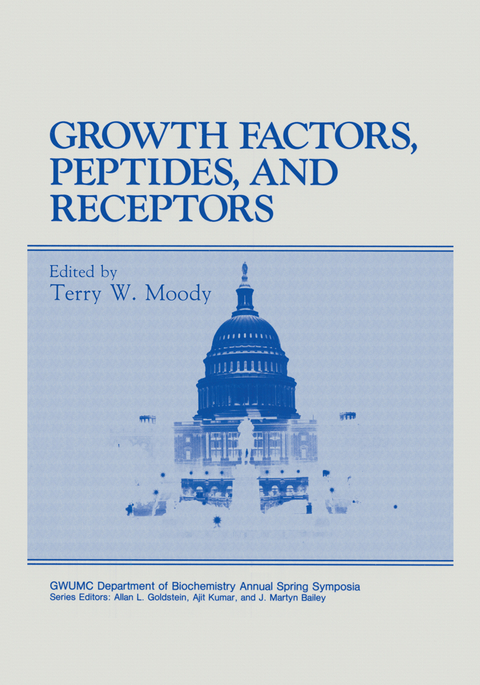
Growth Factors, Peptides, and Receptors
Springer-Verlag New York Inc.
978-1-4613-6232-6 (ISBN)
I—Peptides.- 1. Distribution of Endothelin, a Putative Growth Promoting Peptide, Using Modern Microscopical Imaging Methods.- 2. Vasoactive Intestinal Peptide: From Molecular Genetics to Neurotropism.- 3. Design and Structure/Conformation-Activity Studies of a Prototypic Corticotropin-Releasing Factor (CRF) Antagonist: Multiple Alanine Substitutions of CRF12-41.- 4. Retinoic Acid Regulates preproVIP Expression in the Human Neuroblastoma Cell Line NB-1.- 5. Structure-Dependent Inhibitory Effect of Galanin on Insulin, Gastric Acid and Pancreatic Amylase Secretion in Rat.- 6. Amphibian Opioids: Novel Dermorphin-like Peptides.- 7. Proteases for Neuropeptide Precursor Processing in Bovine Adrenal Medullary Chromaffin Granules.- 8. Amylin and Neuromedin U: Two Novel Regulatory Peptides of the Gastroenteropancreatic System.- II—Growth Factors.- 9. Gene Transfer into the Central Nervous System: Neurotrophic Factors.- 10. The Structural and Biological Properties of Heparin-Binding EGF-like Growth Factor.- 11. Structural Organization of the Multiple Transforming Growth Factor ? Genes.- 12. Dexamethasone Modulates the Response of Rat Stromal Bone Marrow Derived Bone-like Cells to bFGF and IGF-I.- 13. Behavioral, Hormonal and Neurochemical Alterations in Transgenic Mice Overexpressing Transforming Growth Factor ?.- 14. Growth Factors and Brain Injury.- 15. The Basic Fibroblast Growth Factor Isoforms: Endogenous and Exogenous Behavior.- III—Peptide Receptors.- 16. Structural Analysis of Ligand Binding Characteristics for the Bombesin/Gastrin Releasing Peptide Receptor.- 17. Identification of Zeta Opioid Receptor Binding Polypeptides in Rat Cerebellum.- 18. Identification and Characterization of Somatostatin, Gastrin Releasing Peptide, and Neuromedin B Receptors onEstablished Tumors and Tumor Cell Lines.- 19. Neuropeptide Receptor Sub-types: Neuropeptide Y and Calcitonin-Gene Related Peptides as New Examples.- 20. Vasoactive Intestinal Peptide and Astrocyte Mitogenesis: In Vitro and In Vivo Studies.- 21. Synthesis and Biological Activity of Cholecystokinin Antagonists.- 22. Peptide-Neuromedin B Receptor Interactions: Comparison with Gastrin Releasing Peptide Receptor Interactions.- IV—Growth Factor Receptors.- 23. Neurotrophins in the Adult Brain: Effects on Hippocampal Cholinergie Function Following Deafferentation and Regulation of Their Expression by Pharmacological Agents and Lesions.- 24. Angiosuppressive and Antiproliferative Actions of Suramin: A Growth Factor Antagonist.- 25. [125I]IGF-I, [125I]IGF-lI, and [125I]Insulin Receptor Binding Sites in the Rat Hippocampal Formation: Topographic Distribution and Response to Entorhinal Ablation.- 26. Estrogen Regulation of the Pituitary Insulin-like Growth Factor System.- 27. Effects of Radiofrequency Radiation on Growth Factor Receptors.- 28. Structure-Function Analysis of Fibroblast Growth Factor-1 (Acidic Fibroblast Growth Factor).- V—Second Messengers.- 29. MDGF-1: A New Tyrosine Kinase-Associated Growth Factor.- 30. Interleukin-11 Mediated Signal Transduction Pathways: Comparison with Those of Interleukin-6.- 31. Regulation of a Membrane Tyrosine Phosphatase by Somatostatin.- 32. Cycloheximide Has Differing Effects on Immediate Early Gene Expression in IL-3 or M-CSF Stimulated Human Monocytes.- 33. Regulation of Gastrin Releasing Peptide Gene Expression.- VI—Proliferation.- 34. TGF? Induced Proliferative Changes in Transgenic Mice.- 35. Somatostatin and Human Gastrointestinal Cancer.- 36. Inhibition by GnRH Antagonists of Breast and Endometrial Cancer Cell GrowthInduced by Estrogen and Insulin-like Growth Factors.- 37. ?-Endorphin Is Metabolized in Vitro by Human Small Cell Lung Cancer to ?-Endorphin Which Stimulates Clonal Growth.- 38. The Role of EGF and Its Receptors in the Growth of Human Gastric Carcinoma Cell Line (MGC80): Evidence for an Autocrine Mechanism.- 39. The Single-Chain Immunotoxins BR96 sFv-PE40 and BR96 sFv-PE38: Potent Anti-tumor Agents for the Treatment of Human Cancer.- VII—Clinical Correlations.- 40. Hematopoietic Cytokines to Support Repeated Doses of Dose-Intensive Chemotherapy with Cyclophosphamide, Etoposide, and Cisplatin (DICEP).- 41. Interleukin-2 (IL-2) Augments the Expression of Transforming Growth Factor Beta in Patients with Disseminated Cancer.- 42. Peptide Signals for Satiety.- 43. The Role of Somatostatin Receptors in the Diagnosis and Therapy of Cancer.
| Erscheint lt. Verlag | 24.10.2012 |
|---|---|
| Reihe/Serie | Gwumc Department of Biochemistry and Molecular Biology Annual Spring Symposia |
| Zusatzinfo | X, 467 p. |
| Verlagsort | New York, NY |
| Sprache | englisch |
| Maße | 178 x 254 mm |
| Themenwelt | Medizin / Pharmazie ► Medizinische Fachgebiete ► Pharmakologie / Pharmakotherapie |
| Medizin / Pharmazie ► Pharmazie | |
| Naturwissenschaften ► Biologie ► Biochemie | |
| Naturwissenschaften ► Biologie ► Humanbiologie | |
| Naturwissenschaften ► Biologie ► Zoologie | |
| ISBN-10 | 1-4613-6232-6 / 1461362326 |
| ISBN-13 | 978-1-4613-6232-6 / 9781461362326 |
| Zustand | Neuware |
| Haben Sie eine Frage zum Produkt? |
aus dem Bereich


